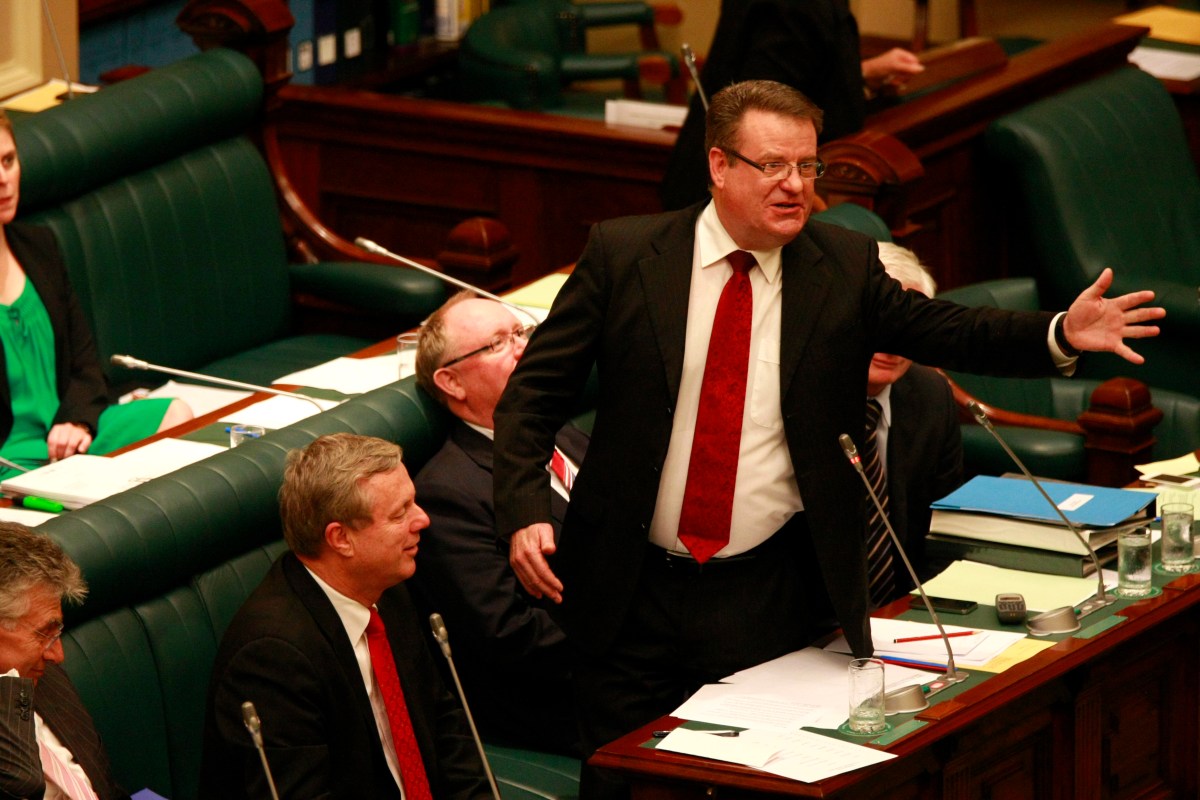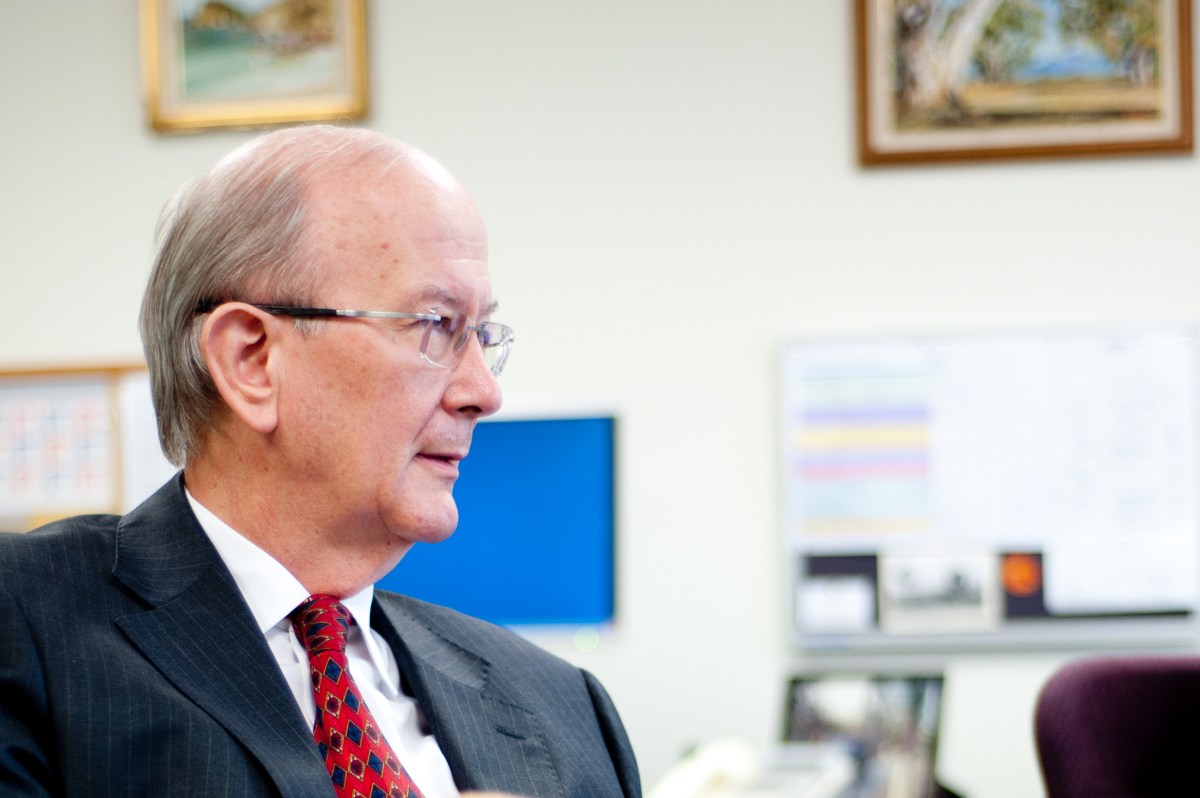Cannon’s farewell blast: SA’s bastion of the Rule of Law
South Australia’s retiring deputy chief magistrate Andrew Cannon reflects on nearly four decades on the bench, highlighting the need for judicial officers of independence and integrity to combat the forces of political opportunism.

The bulwark against fear and tyranny
The Rule of Law prevents the harm we humans intend each other. 3700 years ago the great Babylonian king Hammurabi recognised that he had a choice. Either he could control his community by fear and tyranny or he could manage conflict and maintain an enduring social order by a Rule of Law that expressed and fairly applied community values. He engraved their Rule of Law in basalt. You can see it today in the Louvre.
For the community to have confidence in the fair application of the Rule of Law politicians must surrender part of their power to an independent judiciary, responsible for applying the Rule of Law equally, without fear or favour, affection or ill will.
Power gives politicians a halo of hubris as they are surrounded by the siren songs of sycophancy. Outside of this political echo chamber courts carefully decide if laws have been broken and authorise fair use of state power as a remedy. To do this the judiciary must have courage, integrity, intelligence and independence.

Detail of the stone stele kept at the Louvre, inscribed with laws of Hammurabi. The cuneiform text includes 300 laws and legal decisions governing daily life in the kingdom of Babylon. Photo: David Washington/InDaily
As I searched for fair judgment in the lonely room of conscience, I quickly realised that we can only be effective judges if we are properly supported. I thank all of you who have made my work possible.
First and above all my wife Jan who made family her career. She and our daughters supported me through many late nights, frequent travel and occasional disappointments. Thanks to my endlessly patient and loyal clerks who smoothed what we say in court into grammatically correct, structured written judgments and orders and the Magistrates Court associates who help us to be legally erudite. Thanks to the Registry Staff and Sheriff’s officers who are our face to the public and who convert our thousands of decisions a week into enforceable actions. Thanks to the CAA staff who provide our independent administrative support. Thank you to the police who maintain order in the community and bring defendants to us.
Thank you to the legal profession who make sure that distressed and sometimes difficult clients get a fair hearing, often for too little reward. We all contribute to the safety of our community and the wellbeing of our society.
First lessons
I fell into law because I did not want to be an engineer like my father. As I found my feet as a lawyer I was trained well by David Simmons in commercial work. He taught me that if I ever sent a file to the litigation section then I had failed my client, a wise lesson about the problems with our litigation system. My first reaction to the moral shock of practice was to build a 52-foot ketch, the Clearlight, and for a while, I sailed away.
Tossed around by the ocean like driftwood I learnt that with perseverance and courage you can make your destination, useful lessons for the practice of the law, and for life. I left commercial practice to start a partnership with Michael Sykes defending criminals. Criminal law is simpler than civil work. There is more aggro but fewer lies. I did two jury trials and I think the jury got each of them wrong.
The first defendant, caught red-handed, was acquitted. Videos ended verbals, but back in those days the second, verballed by a corrupt cohort from the drug squad, got three years for dealing heroin that they took from the police safe. I acknowledge that my inexperience might have let the jury down. When I came across an advertisement for magistrates, I thought I might be able to do a better job inside the judicial system rather than outside. After a public service selection process I was appointed in September 1979.
Independence
Magistrates then were public servants. Some of us new bloods made it our mission to join the independent judiciary. It took four years to make South Australian Magistrates one of the first in Australia to be free of executive government control under the Magistrates Act 1983 (SA). The late Len King was then Chief Justice and he spent a decade convincing the government to pass the Courts Administration Authority Act 1993 to provide us with independent court staff. You knew that Len would support your independence and integrity. I have not always felt so secure in either respect since.
In September 1987 I wrote to the Chief Magistrate Nick Manos saying the next step was to ensure that the appointment process for the judiciary was fair, transparent and merit-based, otherwise to quote Jeremy Bentham in “the dark place of secret processes, sinister interest and evil in every shape have full swing.”[1] Some challenges are greater than others and 35 years later, although the process for appointing magistrates has improved, we often do not apply our cherished principles of procedural fairness to judicial appointments. Where judicial appointments come only from elites, the judicial system risks speaking insular irrelevancies. I have watched political networking by government lawyers from school, religious and gender cells, and secret denigration, often trump merit in opaque selection processes.
I have watched politicians and their media lackeys use fear discourse in a way which undermines the courts and the legal profession.
In his valedictory vapours, delivered under privilege, a past Attorney-General said I had not previously been appointed as chief magistrate by one of his predecessors because I failed the character test. New members of the judiciary usually rise to this important role and quickly learn in the face of unwarranted attacks that independence and integrity can be partners of loneliness. Even so, we keep our focus on the task of giving a fair go without fear or favour and in accordance with the Rule of Law. The courts in this state have a lot to be proud of, maintaining our independence through the Courts Administration Authority and serving our community with many leading innovations in civil procedure and sentencing processes.
Community
Sustaining our community is our work. When I was at university, Aboriginals were non-citizens banished to the fringes of our society until the referendum of 1967. This court led Australia by involving elders in our processes so that our community embraces the Nungas and Anangu. We have been copied around the country and independently evaluated as best practice. I hope that we can now all be one community not divided by race or background.
I have personally engaged in many community activities including work as chair of the Australia Day Council, Chair of the education committee of the Australasian Institute of Judicial Administration, deputy Chair of LEADR when it amalgamated with IAMA to create the dynamic Resolution Institute and presently Chair of the DRSC supporting the important role of Reservists in this Defence State. I have lectured at all three law schools here and two in Germany as well as providing internships for keen young German law students. In my spare time, I also did a PhD which critically evaluated our rule reforms.
Adversary mindset
In time other important challenges soon came my way. In 1992, the District Court was not coping with its civil workload so a large part of it was shifted to the Magistrates Court without any extra resources. We were trusted with our own rulemaking power. We looked at the Supreme Court rules and saw an adversary litigation model, with rules that are as long as their list delay and cost scales that reward prolix inefficiency. They offer the Ritz hotel of litigation, affordable only by the very rich and patient, government, corporate heavyweights and plaintiffs accessing insurance funds. The failure of that model led to the shift of work to the Magistrate’s court in 1992 and again in 2013, when our civil jurisdiction more than doubled and we can now sentence in major indictable matters. Each time the higher level work came without increased resources.
We need to be ever vigilant to protect against the Executive taking the power and changing the purpose of punishment.
With our own rules, this people’s court absorbed the work and continued to provide a prompt, affordable and just the Rule of Law to the community. Our successful innovations include assessment by court experts, mediation, electronic filing, continuous management of files by the deciding magistrate and cost scales that are proportionate to the amount in dispute with penalties to discourage exaggerated claims. A senior figure in Adelaide legal circles has said that once Cannon goes, we can get rid of his cost scale and some think that we should impose old-fashioned Bleak House rules on this court instead of our own. Conformity is not necessarily a virtue.
Erosion of rights
I say to them that a win at too high a cost is no win at all. The adversary litigation mindset focused on exploiting procedure above finding the fair solution drives potential litigants away from our courts so that the Rule of Law withers on the vine.
Society is finding other ways to deal with conflict at the risk of injustice and loss of rights. Personal injury litigation is an example. When I was a lad, my father had an accident and the other driver’s whiplash claim was heard in the Supreme Court. Then whiplash claims shifted to the District Court and became a lawyer cash cow. In 1994 the legal and medical professions made more than $41 million out of motor vehicle personal injury claims in South Australia[2]. In response, the South Australian government has now raised such a high barrier to making any claim that whiplash injuries no longer count as pain and suffering, and neither does a man who loses a testicle.
We still pay compulsory insurance when we register our cars but it no longer covers our most common injuries. The personal injury goose was killed by a failed litigation model, and much of the Rule of Law with it. And the golden egg went to treasury when it sold MAC.
Whom do we serve?
I have contributed to a better litigation process to the best of my ability honed by years of study and scholarship in the law. I have left a legacy of efficient and sustainable process rules so that litigation in the Magistrates Court serves the community by making people pay their proper debts. We do not serve greedy plaintiffs, cheating defendants and those who exploit them to make money rather than to seek justice.
I have had the privilege of managing the Wardens Court for many years. It has gone well. Quietly the Wardens find solutions for fraught relationships between landowners and miners, also for fractious disputes on the opal fields. The Wardens Court rules are only three pages long. We encourage simple processes and look for mutually beneficial arrangements and where necessary bring matters to trial in three months.
Under a Rule of Law, politicians don’t jail criminals, courts do.
I convinced opal miners on Lambina Station that they had to put the dirt back in their claims with the topsoil on top – no mean achievement. I inspected the rehabilitated field and I was amused to see a large granite boulder amongst the reviving scrub painted with the words: “Which Bank? $1.5m deposit removed”!
By providing clear criteria for managing access, rehabilitation and compensation we have helped mining projects contribute to the state’s wealth, whilst protecting farmers and community wellbeing. Warden Fahey, my successor as Senior Warden, and I were pleased to meet the farmers at Mindarie 10 years after mining and they showed us their rehabilitated fields that return as good or better harvest than before the mining. Don’t lock the gate. Open it constructively.
The high cost of imprisonment
I ran the restoration of the historic ketch Falie for the 1986 state sesquicentenary and the grain trade re-enactment which celebrated the important connections between our country and city communities. I then helped to run Falie and later the One and All as community and sail training vessels, giving our youth character building opportunities. During this I spent a great deal of time with sentenced offenders from Yatala Labour Prison, bagging 90 tonnes of iron ore fines and then putting them into the hull of Falie as ballast. Meanwhile, the belaying pins and other equipment for the Falie were made in the prison workshops at Yatala.

Kevin Foley wanted to “rack’ em, pack ’em and stack ’em”. Photo: AAP/ James Baker
The Department of Corrections annual report in 1984-85 celebrated the introduction of community service as an alternative to imprisonment because it was concerned that the prison population had reached 560. The population of the state was then 1.3 milion. It is now 1.7 million – about a 30 per cent increase. Crime rates are fairly stable, so to maintain the same ratio we should today have a prison population of about 750. It is now 3000. So we have about 2000 more people in prison than we need to keep us safe. Each one costs $100,000 so that is $200 million p.a. which could be better spent on a safe child welfare system, active drug, alcohol and gambling addiction programs, good mental health and disability accommodation and support and better programs to reduce homelessness. These would lower crime rates much more than overpopulated prisons, where the most effective education is postgraduate training in crime.
Kevin Foley said he was proud to rack, pack and stack criminals in our overcrowded prisons. In my view, such an approach is inhumane and displays constitutional ignorance. Under a Rule of Law, politicians don’t jail criminals, courts do.
I waited in vain for the judicial leaders in this state to stand up for our Rule of Law role and the separation of powers. I had inspected the city watch house where double bunked prisoners were locked down for 23 hours per day, “apparently” watched by a video camera in the cell, although they are not wired to a control room.
Prisons are housing people with mental health problems. Remand prisoners are being kept with sentenced prisoners. Education and skills training for sentenced prisoners is limited due to overcrowding.
Treating people badly does not make them better.
A better path
Eventually, I took up the cudgels myself, referencing Australia’s human rights obligations in several judgments, taking prison overcrowding into account as a factor in my sentencing. When the then Attorney-General publicly attacked me, I sued and vindicated my good reputation. That was a difficult time. I was despatched by the court back to the civil jurisdiction. But then I like civil work. I thank my friends and the JCA for their support during that time. I noticed those who chose to cross the street to avoid me, as their self-interest trumped friendship.
A better path than punishment is to pursue ways to solve offenders’ problems so that it is not necessary to lock them away. We established the first family violence court and treatment program in Australia, the second drug court in Australia and the first mental health court in Australia. Our mental health court was copied in Queensland. It’s such a good court that the then Health Minister came back from a visit to the Queensland copy and recommended that we establish the same thing here. Oh dear.
Last time I heard, the financially poor Aboriginal community of a few hundred at Yalata had collective fines and levies of over half million dollars
We also tried a victim-offender conferencing program. There are better ways to help victims than trying to balance their pain with a defendant’s incarceration time. That is a lose-lose approach. Our program was independently assessed as highly successful and promptly defunded. Despite political indifference and sometimes opposition we have continued to try to fix the underlying causes of crime and create courts that dispense justice in a positive and constructive way rather than merely being reactive and punitive.
This constructive approach received an unexpected boost from the Premier’s Thinker in Residence program. The banal selection criteria that fell from the Premier was only that the justice Thinker should be a woman and preferably not from England. I am not sure that my suggestion of Judge Peggy Fulton Hora was what he had in mind, but I credit her with helping to turn the “Law and Order” discourse around to “Smart on Crime” and only locking up the “ones” we are scared of – those who pose a genuine risk to the community. Jail is necessary but should be used sparingly.
Independent assessment
In times of change, it is important to have new models independently assessed. I have been privileged to work with Professor Kathy Mack and Professor Sharon Roach Anleu from Flinders University who have conducted meticulous research on the changing role of the Magistrates Court. Again it was South Australia that initiated this national project of great significance to the legal academic world. Their continuing record of the Magistrates Courts’ increasingly important role in the third arm of government will stand the test of time.
Executive power
We need to be ever vigilant to protect against the Executive taking the power and changing the purpose of punishment. Fines are a case in point.
A hard-working woman who ran a takeaway food shop at Murray Bridge and lived at Brighton appeared before me in a distressed state. She drove every day up the freeway to work and back. She overlooked the registration and the compulsory insurance and she incurred fines from the cameras of some $16,000 before she received the first expiation notice. The Sheriff was about to seize and sell her clapped out little Hyundai Excel and so cast her out of work and into desperate poverty. Fortunately, I had the power to reduce the fines and save the car. But since then fines collection has been moved from the courts to the Attorney-General’s office so that we no longer have that power. Next time she may lose the car.
Last time I heard, the financially poor Aboriginal community of a few hundred at Yalata had collective fines and levies of over half million dollars. The prosecution costs and victims of crimes levies that we are required to order often overwhelm any capacity to pay.
Most fines now are imposed by police and not the courts and are counted as an income stream by Treasury. People on welfare can never pay them so they lose their deterrent effect. And legislation has now been passed so that the state no longer has to sue to claim a debt. Government departments can just register debts with the Fines Recovery Unit as if they were fines. This rule by administrative fiat effectively steals the Rule of Law from the independent courts. And at the same time, I have watched politicians and their media lackeys use fear discourse in a way which undermines the courts and the legal profession.
A heavy responsibility
We forget the lessons of our past at our own peril. Hammurabi was right. It is the judiciary that maintains social order by fairly applying the Rule of Law. The alternative is only tyranny, as we saw in the last century when many more citizens were killed by the own governments than by criminals or terrorists. Stalin, Mao Zedong, Hitler, Idi Amin, Pol Pot, Assad, Katanga, the Congo, Rwanda. The first institution tyrants suborn is the judiciary to unbridle their power, and then the press to keep their abuse of that power silent, and then the academy to still considered criticism.

Retired deputy chief magistrate Andrew Cannon. Photo: InDaily
Courts need to be ever vigilant to maintain their integrity and independence. And we need to develop their own direct discourse with the public to defend the community values that we stand to protect, as my good friend Dr Pamela Schulz has long proposed.
Through all my time here, this court, all of us, magistrates, our staff, and police prosecutors and the legal profession have stood as a bastion of the independent Rule of Law. We have led Australia in reforming our processes so that we are prompt, affordable and compassionate to protect and improve the community in a sustainable way.
But time is the ruler of us all and now my magistrate’s clock shows 12. I prefer to think of that as midday, rather than midnight, for I intend to do many new things in the afternoon of my life.
I leave my colleagues with a heavy responsibility. The Rule of Law delivers the gift of a free civil society to our community. I leave you in safe hands. Thank you for the opportunity to serve.
Dr Andrew Cannon AM reached mandatory retirement age last Friday after nearly 39 years as a magistrate. This is an edited version of his farewell speech delivered at a special sitting of the Magistrates Court on his retirement day.
[1] Attorney General of Nova Scotia v. MacIntyre [1982] 1 R.C.S. 175 quoting from Jeremy Bentham
[2] Cannon, “Electronic Pre-lodgement Notices” (2001) 4 UTS Law Review 91-104




